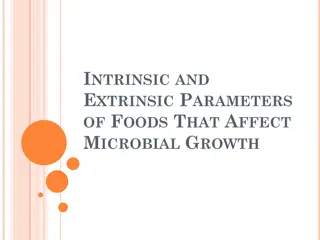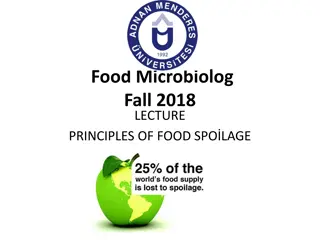Factors Affecting Microbial Growth in Foods
Moisture content and pH levels are key factors influencing the growth and survival of microorganisms in foods. The water activity (aw) of food substrates affects microbial growth, with bacteria and fungi having varying requirements. Lowering aw below optimum levels can increase the lag phase of growth. pH levels also play a significant role, with different microorganisms thriving in specific pH ranges. Understanding these factors is crucial for food preservation and preventing spoilage due to microbial contamination.
Uploaded on Sep 08, 2024 | 2 Views
Download Presentation

Please find below an Image/Link to download the presentation.
The content on the website is provided AS IS for your information and personal use only. It may not be sold, licensed, or shared on other websites without obtaining consent from the author.If you encounter any issues during the download, it is possible that the publisher has removed the file from their server.
You are allowed to download the files provided on this website for personal or commercial use, subject to the condition that they are used lawfully. All files are the property of their respective owners.
The content on the website is provided AS IS for your information and personal use only. It may not be sold, licensed, or shared on other websites without obtaining consent from the author.
E N D
Presentation Transcript
UNIVERSITY OF BASRAH / COLLEGE OF SCIENCE LECTURE 6 FACTORS AFFECTING THE GROWTH AND SURVIVAL OF MICRO-ORGANISMS IN FOODS Department of Pathological Analyses Presented by Prof.Dr. Saad S. Mahdi Al-amaradi Al-Amara
Moisture content One of the oldest methods of preserving foods is drying or desiccation; precisely how this method came to be used is not known. The preservation of foods by drying is a direct consequence of removal or binding of moisture, without which microorganisms do not grow. It is now generally accepted that the water requirements of microorganisms should be described in terms of the water activity (aw ) in the environment. This parameter is defined by the ratio of the water vapor pressure of food substrate to the vapor pressure of pure water at the same temperature: aw = p/ po , where p is the vapor pressure of the solution and po is the vapor pressure of the solvent (usually water). This concept is related to relative humidity(RH) in the following way: RH = 100 aw .
Moisture content Pure water has an aw of 1.00, a 22% NaCl solution (w/v) has an aw of 0.86, and a saturated solution of NaCl has an aw of 0.75 . The water activity (aw ) of most fresh foods is above 0.99. In general, bacteria require higher values of aw for growth than fungi, with Gram-negative bacteria having higher requirements than Gram positives. Most spoilage bacteria do not grow below aw = 0.91, whereas spoilage molds can grow as low as 0.80. With respect to food-poisoning bacteria, Staphylococcus aureus can grow as low as 0.86, whereas Clostridium botulinum does not grow below 0.94. Just as yeasts and molds grow over a wider pH range than bacteria, the same is true for aw . The lowest reported value for foodborne bacteria is 0.75 for halophiles (literally, salt-loving ), whereas xerophilic ( dry-loving ) molds and osmophilic (preferring high osmotic pressures) yeasts have been reported to grow at aw values of 0.65 and 0.61.
Moisture content Effects of Low aw The general effect of lowering aw below optimum is to increase the length of the lag phase of growth and to decrease the growth rate and size of final population. This effect may be expected to result from adverse influences of lowered water on all metabolic activities because all chemical reactions of cells require an aqueous environment. It must be kept in mind, however, that aw is influenced by other environmental parameters such as pH, temperature of growth, and Redox Potential Eh.
pH and Buffering capacity Acidity or alkalinity significantly impacts macromolecules, affecting the growth and metabolism of microorganisms. Bacteria grow fastest in pH ranges 6.0-8.0, while yeasts and filamentous fungi grow at pHs 4.5-6.0. However, lactobacilli and acetic acid bacteria thrive in pHs 5.0-6.0. Most foods are slightly acidic, as alkaline materials have an unpleasant taste. Acidity affects a product's microbial ecology and spoilage rate. For example, vegetables have moderately acidic pHs, with soft-rot-producing bacteria playing a significant role in spoilage. Fruits have lower pHs, preventing bacterial growth and spoilage dominated by yeasts and molds.
pH Effects Adverse pH impacts the functioning of enzymes and nutrient transport in respiring microbial cells. Microorganisms' cytoplasmic membrane is impermeable to H+ and OH ions, ensuring their concentration remains constant. The intracellular pH of resting baker's yeast cells is 5.8, and their ability to proliferate depends on their ability to bring the environmental pH to an optimum value. In acid environments, cells must either keep H+ from entering or expel H ions as quickly as they enter. Nonionized compounds can enter cells at neutral or alkaline pH, while ionized compounds cannot. The ionic character of side chain ionizable groups is affected on either side of neutrality, leading to increased denaturation of membrane and transport enzymes.
Redox Potential, Eh It has been known for decades that microorganisms display varying degrees of sensitivity to the oxidation reduction potential (O/R, Eh) of their growth medium. The O/R potential of a substrate may be defined generally as the ease with which the substrate loses or gains electrons. When an element or compound loses electrons, the substrate is oxidized, whereas a substrate that gains electrons becomes reduced: Oxidation may also be achieved by the addition of oxygen, as illustrated in the following reaction: Therefore, a substance that readily gives up electrons is a good reducing agent, and one that readily takes up electrons is a good oxidizing agent.
Redox Potential, Eh Aerobic microorganisms require positive Eh values (oxidized) for growth, whereas anaerobes require negative Eh values (reduced) With respect to Eh requirements of microorganisms, some bacteria require reduced conditions for growth initiation (Eh of about 200 mV), whereas others require a positive Eh for growth. In the former category are the anaerobic bacteria such as the genus Clostridium; in the latter belong aerobic bacteria such as some members of the genus Bacillus.
Antimicrobial constituents Certain foods are stable against microorganisms due to the presence of naturally occurring substances with antimicrobial activity. Plant species like cloves, garlic, cinnamon, mustard, and sage contain essential oils with antimicrobial properties. Cow's milk contains lactoferrin, conglutinin, and lactoperoxidase systems. Raw milk contains a rotavirus inhibitor, which is destroyed by pasteurization. Milk casein and free fatty acids are also antimicrobial under certain conditions. Eggs contain lysozyme and conalbumin, providing an efficient antimicrobial system. Hydroxycinnamic acid derivatives in fruits, vegetables, tea, and molasses also show antibacterial and antifungal activity.
Biological structure Some foods have natural coverings that protect them from spoilage organisms. These include the outer covering of fruits, the shell of nuts, the hide of animals, and the shells of eggs. Nuts like pecans and walnuts have a shell that prevents spoilage, while eggs have an intact outer shell and membrane. Damaged coverings cause spoilage faster than undamaged ones. Fish and meats have a skin covering that prevents contamination due to faster drying out.
Extrinsic Parameter The extrinsic parameters of foods are not substrate dependent. They are those properties of the storage environment that affect both the foods and their microorganisms. Those of greatest importance to the welfare of foodborne organisms are as follows: 1. temperature of storage 2. relative humidity of environment 3. presence and concentration of gases 4. presence and activities of other microorganisms
Temperature of storage Microorganisms grow over a wide range of temperatures, making it crucial to consider their temperature growth ranges when selecting the appropriate storage temperature for different food types. Microorganisms are classified into three groups based on their growth requirements: psychrotrophs, mesophiles, and thermophiles. Psychrotrophic species and strains are found in various genera, such as Alcaligenes, Shewanella, Brochothrix, Corynebacterium, Flavobacterium, Lactobacillus, Micrococcus, Pectobacterium, Pseudomonas, Psychrobacter, and Enterococcus. Pseudomonas and Enterococcus are the most common psychrotrophs found on foods, as they grow well at refrigerator temperatures and cause spoilage at 5-7 C. Mesophilic species and strains are also known among all genera and can be found on foods held at refrigerator temperatures. Some organisms can grow over a range from 0 C to >40 C, such as Enterococcus faecalis.
Temperature of storage Thermophilic bacteria, such as Bacillus, Paenibacillus, Clostridium, Geobacillus, Alicyclobacillus, and Thermoanaerobacter, are crucial in food microbiology and canning industry. Molds and bacteria can grow over various pH, osmotic pressure, and nutrient content ranges, including refrigerator temperatures. Some strains of Aspergillus, Cladosporium, and Thamnidium can grow on eggs, beef sides, and fruits. Yeasts grow over psychrotrophic and mesophilic temperature ranges but not within thermophilic range. Selecting the right storage temperature depends on food product quality.
Relative Humidity of Environment The relative humidity (RH) of a food's storage environment is crucial for its aw and microorganism growth. A food with an aw of 0.60 should be stored under conditions that prevent moisture from absorbing, allowing it to grow. When foods with low aw values are placed in high RH environments, they pick up moisture until equilibrium is established, while foods with high aw lose moisture when placed in low RH environments. The relationship between RH and temperature is important in selecting the right storage environment. Foods that experience surface spoilage from molds, yeasts, and certain bacteria should be stored under low RH conditions. However, storing under low RH conditions can lead to the loss of moisture to the atmosphere, making the food undesirable. Therefore, the optimal RH conditions should balance surface growth and food quality.
Presence and Concentration of Gases in the Environment Carbon dioxide (CO2) and ozone (O3) are crucial atmospheric gases used to control microorganisms in foods, with CO2 and O2 being the two most important gases in modified atmosphere packaged (MAP) foods. Ozone has antimicrobial properties and has been used to extend food shelf life, but should not be used on high-lipid-content foods due to its strong oxidizing effect. Ozone was tested against Escherichia coli 0157:H7 in culture media. Presence and Activities of Other Microorganisms Some foodborne organisms produce substances that are either inhibitory or lethal to others; these include antibiotics, bacteriocins, hydrogen peroxide, and organic acids.























